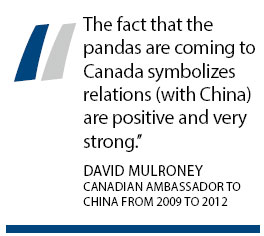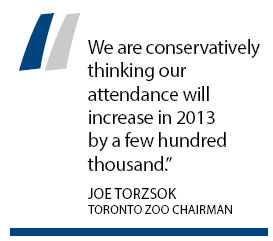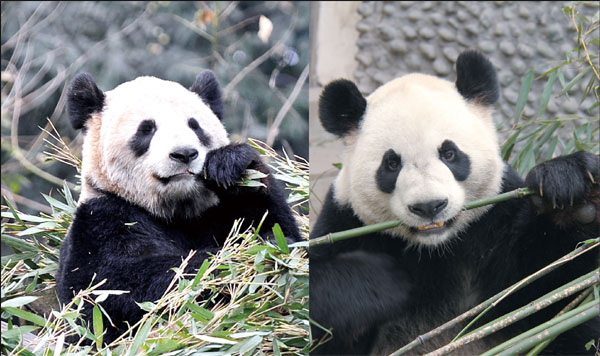Zoos get ready for 'panda-monium'
Updated: 2013-03-22 11:28
By Li Na and Eddy Lok (China Daily)
|
||||||||
|
Left: Er Shun, a 5-year-old female, chomps on bamboo, the favorite food of giant pandas. Er Shun is from Chongqing, a sister city to Toronto. She Ying / For China Daily Right: Da Mao, a 4-year-old male, is from Chengdu. Cui Kai / Courtesy of Chengdu Research Base of Giant Panda Breeding |
Giant pandas Er Shun and Da Mao will soon leave China for their 10-year stay in Canada, the latest step in improved relations between the two countries, report Li Na and Eddy Lok from Toronto.
The Toronto and Calgary zoos are about to become the home of a chorus of "oohs" and "aahs" for 10 years as "panda-monium" arrives from China with Er Shun and Da Mao.
The cuddly giant pandas with their big eyes in black sockets, pug noses, round faces and toddler-like tumbles are scheduled to be shipped by Federal Express to Toronto on March 25 and will be quarantined for four to five weeks before public viewing. Er Shun (a 5-year-old female) and Da Mao (a 4-year-old male) will spend five years in Toronto before moving to the zoo in Calgary.
It will mark the first time China has loaned pandas to Canada since the 100-day visit by Qing Qing and Quan Quan in 1985. Er Shun's and Da Mao's extended stay is being touted as a sign of progress in relations between China and Canada.
"The fact that the pandas are coming to Canada symbolizes relations (with China) are positive and very strong," David Mulroney, who served as Canadian ambassador to China from 2009 to 2012 and who speaks Mandarin, said in an interview with China Daily. "Pandas should be a key to the door, they allow us to open, understand and build awareness (of each other)."
Mulroney's tenure as ambassador coincided with a change in the Canadian government's attitude toward China. The early years of the Conservative administration of Prime Minister Stephen Harper were marked by cool relations. Ottawa publicly criticized China's human rights record and made the exiled Dalai Lama an honorary Canadian citizen. Harper also didn't attend the opening ceremonies of the 2008 Olympics in Beijing.
With the global recession and declining trade with the US, the economically robust China returned to Canada's foreign policy agenda with Harper's first visit to China in 2009. On his second visit in February 2012, Harper signed economic agreements, including a uranium export treaty and a foreign-investment treaty, and he announced China had agreed to loan the two pandas.
Panda diplomacy

Use of the pandas in China's international relations isn't new. As home to nearly all of the world's wild giant pandas, China has practiced panda diplomacy since the Tang Dynasty (AD 618-907), when Empress Wu Zetian (AD 624-705) sent a pair of the animals to the Japanese emperor as a gesture of goodwill. Panda diplomacy was revived by the Chinese government in the 1950s, with the practice being continued for decades until 1984, when China began to offer pandas only on 10-year loans.
Panda diplomacy presents Chinese "soft power" and non-threatening influences, said Mulroney, now a senior distinguished fellow at Canada Centre for Global Security Studies at the Munk School of Global Affairs.
Mulroney said he saw the tone in China-Canada relations change, leading to development of a more comprehensive relationship between the two countries. "We can build on this and make this happen," he said, referring to the present good relations of the two countries at the highest level and good working relations.
Echoing Mulroney's sentiments is Ming-Tat Cheung, chairman and president of the Chinese Cultural Centre of Greater Toronto.
"I think this exchange will bring a better understanding of culture and heritage of both countries through the grassroots people," he said. "It will improve the already friendly relationship between us.
Cheung was appointed the chair of the Giant Panda Acquisition Task Force by the Toronto Zoo management board to spearhead the project in December 2009. Toronto is home to 450,000 Chinese. More than 1.3 million Canadian residents are of Chinese origin, with well over 68,000 Chinese students at Canadian educational institutions. Chinese is Canada's third most spoken language after English and French.
"There has long been a desire in the community to see the return of the giant pandas but it was impossible to make this happen until the (cold) relationship took a major turn," he said. "The window of opportunity opened for this project with Harper's visit to China."
Cheung also said the billions of dollars of investment in Canadian oil sands from China in the recent months is a further sign of warmer relations between the two countries.
Mulroney said that Canada is one of the most open countries to Chinese investments, and he saw no reason why it should slow down. "Foreign investments always generate some concerns," he said. "Who are these people? Who is coming to town? Will they create jobs?"
In February 2013, China National Offshore Oil Corporation (CNOOC) closed its $15.1 billion takeover of Nexen Inc, the Canadian oil and gas company. China's largest-ever overseas acquisition was first announced in July 2012 and it sparked concern in Canada over strategic assets ending up in foreign hands. The Canadian parliament approved it in December.
The deal is China's latest effort by to find new sources of oil and natural gas reserves to help drive its domestic growth. The takeover gives China's biggest offshore oil and gas explorer control of a company with assets in western Canada, the UK's North Sea, West Africa and Gulf of Mexico, as well as producing properties in the Middle East and Canada.
The acquisition will increase CNOOC's proven oil and gas reserves by 30 percent and its output by 20 percent, and provide it with valuable technology assets, especially in shale-gas exploration. Through the Nexen deal, CNOOC will gain control of the massive Syncrude oil sands project in Canada, which has been in production for 34 years.
On Canadian domestic concern about Chinese investments, Mulroney said problems arise due to lack of understanding of the nature of Chinese companies wanting to invest in Canada, for instance, and he stressed the need for both sides to build understanding.
"We encourage dialogues; government to government, private sector to private sector, university to university and find out which countries are going into energy development, their needs, infrastructure that we intend to put in place as well as environment issues," he said.
Meanwhile, at the Toronto Zoo, meeting the needs of the two giant pandas and readying their environment are being completed.
Saving money

Zoo Chairman Joe Torzsok said the area for the Siberian tiger has been renovated into the pandas' home, with no new facilities being built for them."We want to save money for taxpayers; instead of building a new special panda exhibit, we decided to make the existing tiger renovations panda-friendly," he said .
Hosting the pandas is expensive. Rent on them to China is $1 million a year, and there's a $200,000 charge if a cub is born. Females are only fertile, or in their reproductive cycle, for about five days. If Er Shun becomes pregnant, the pair could stay longer in Toronto. The cub or cubs will remain the property of China under international conservation laws and must be returned to China after the loan.
As for food, the bamboo pandas love can cost close to $200,000 a year. A panda will eat half the day or more and relieves itself dozens of times a day. Its digestive system is more similar to that of a carnivore than an herbivore, and much of what is eaten is passed as waste. It takes 20 to 40 pounds of bamboo to satisfy a giant panda's daily dietary needs. Pandas will sometimes eat birds or rodents as well.
"The zoo will break even on this panda exhibit and then some," Torzsok said.. "And that money will be used to support our conservation, education and research work. We're absolutely certain this is no cost to the taxpayers."
Giant pandas have a highly developed sense of smell. Males use it to avoid each other and to find females for mating in the spring. After a five-month pregnancy, females give birth to a cub or two. The blind cubs weigh only 5 ounces at birth and cannot crawl until they are three months old. They are born white and develop their coloring later.
The last time pandas were at the Toronto Zoo in 1985, a record 1.9 million people visited the zoo during the three-month exhibit. Attendance last year increased to 1.29 million from 45,000 in 2011, according to Torzsok.
"We are conservatively thinking our attendance will increase in 2013 by a few hundred thousand," Torzsok said. "The closest zoos to Toronto that have pandas are Memphis and Washington, DC, so we certainly expect people from across Ontario and nearby in the US to come visit us."
Toronto City Councillor Giorgio Mammoliti projected 2.5 million to 3 million visitors annually during the five years the pandas are in Toronto."We would certainly love it if we had those numbers," said Torzsok.
On handling and caring for the pandas, Torzsok said the zoo will be hosting some experts from China who will help "so rest assured our special guests will get the best care."
Though they are lovable, pandas can be vicious,Calgary Zoo President Clement Lanthier told the Star.com. "They're not pets, they're still wild animals," she said.
Nevertheless, there are the "oohs" and "aahs"when people see pandas. Why?
"They're pretty, they're cute, they're round, and the way they sit, the way they move, the way they eat, it's very anthropomorphic (their behaviors have human characteristics)," said Lanthier. "So because of that human (aspect) we love them. We can identify ourselves in those animals."
Contact the writers through renali@chinadailyusa.com

 In Photos: 7.0-magnitude quake hits Sichuan
In Photos: 7.0-magnitude quake hits Sichuan
 Li Na on Time cover, makes influential 100 list
Li Na on Time cover, makes influential 100 list
 FBI releases photos of 2 Boston bombings suspects
FBI releases photos of 2 Boston bombings suspects
 World's wackiest hairstyles
World's wackiest hairstyles
 Sandstorms strike Northwest China
Sandstorms strike Northwest China
 Never-seen photos of Madonna on display
Never-seen photos of Madonna on display
 H7N9 outbreak linked to waterfowl migration
H7N9 outbreak linked to waterfowl migration
 Dozens feared dead in Texas plant blast
Dozens feared dead in Texas plant blast
Most Viewed
Editor's Picks

|

|

|

|

|

|
Today's Top News
Live report: 7.0-magnitude quake hits Sichuan, heavy casualties feared
Boston suspect cornered on boat
Cross-talk artist helps to spread the word
'Green' awareness levels drop in Beijing
Palace Museum spruces up
First couple on Time's list of most influential
H7N9 flu transmission studied
Trading channels 'need to broaden'
US Weekly

|

|








